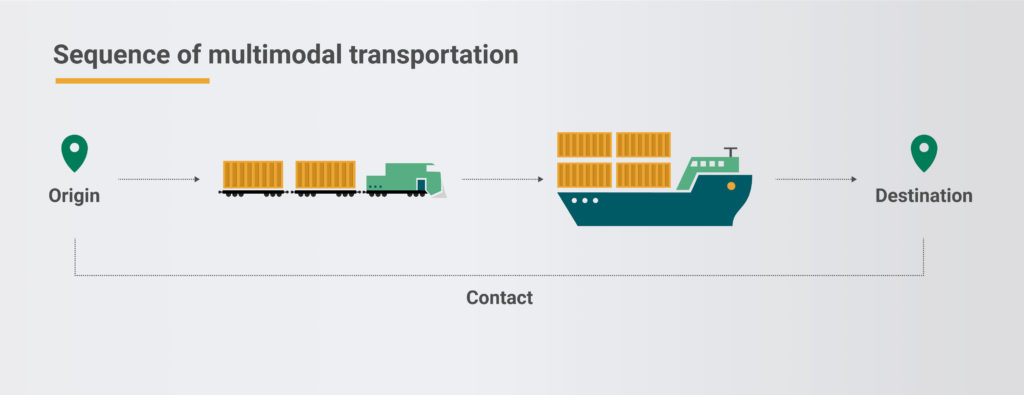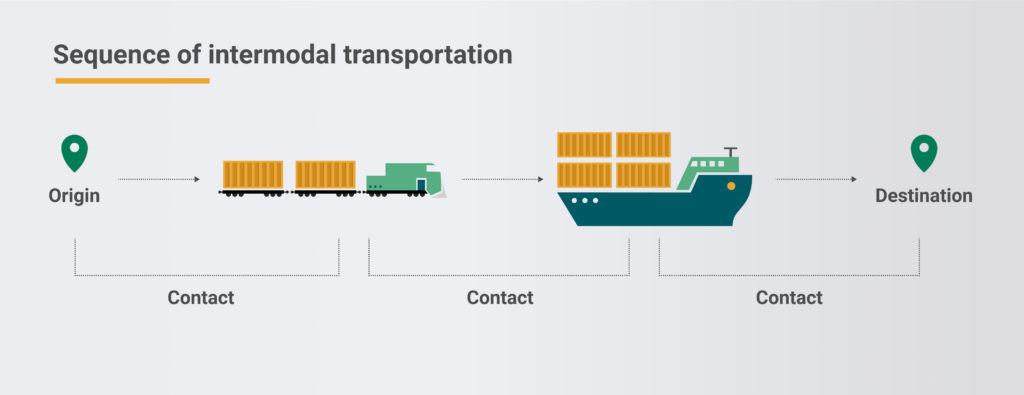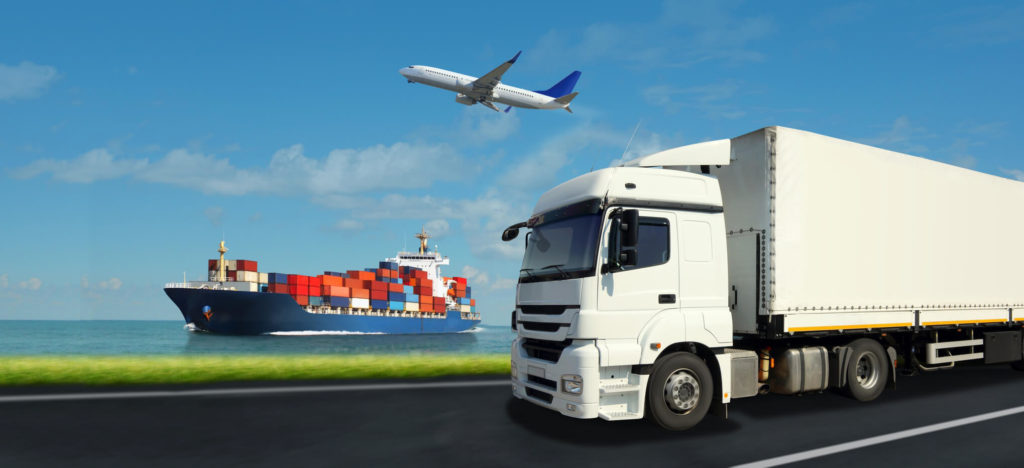The use of intermodal transportation in the logistic supply chain has taken a paradigm shift over the last few decades. And why not? These containers can be used across different modes of transport – saving time, money, and effort. Let’s learn all about intermodal, as well as multimodal transport in this blog post.
Intermodal is a transportation method that involves the use of more than one mode of transport to move cargo. Exceptionally good for long-haul services, it is a cost-effective option and can save fuel costs up to 30%. In the transportation industry, intermodal or ISO containers are a key to achieve geostrategic goals and regulate geo-traffic. While also being sustainable and improving supply chain operations.
While moving your cargo from one place to another, it’s important to decide the best transportation route, in order to get the deliveries from door to door. This is when the choice between multimodal and intermodal transportation comes to play.
Understanding the difference between the two is important when choosing a carrier for your cargo. However, many times, these terms pose confusion and are used incorrectly or interchangeably. To make your understanding easy and simple, let’s dive in and look at the differences between multimodal and intermodal transportation.
What is Intermodal transportation?
Intermodal transportation is a combination of two or more modes of transport in order to move cargo from a place in a country to another place in a different country. The main characteristic of intermodal transportation mode is that every part of the process is contracted with different providers. If you’re looking for an in-depth explanation of intermodal, you can get that right here.
Intermodal transportation with example
Let’s use an example to understand the term better. You want to move cargo from Munich to Singapore. In the beginning, a truck (hired by you) would bring an empty container to pick up the cargo. Once the container is fully loaded in Munich, the truck takes the container to a railroad yard to move it to Hamburg. It’s then put on a container ship. Your carrier takes full responsibility until your shipment reaches Singapore.
At the destination (Singapore), a truck (again hired by you) picks up the container from the container terminal and delivers your cargo to the consigneeWhat is a consignee? When transporting freight (by ocean, air, or land), there are two parties involved — one who is shipping and the other who is receiving the freight. The recipient of the goods b... More. Here, the containers are unloaded.
In this case, it’s an intermodal operation as it involves several contracts, between different transport service providers (truck, rail, sea) and between the buyer and seller.
Note: It’s easy to chase the best terms (separately) with each company when using intermodal transportation. However, this means more overhead for shippers, as they need to keep track of several contracts with different providers. They’re also responsible for handling the coordination of delays.
What are intermodal shipping containers?
These containers are manufactured according to the International Organization for Standardization (ISO) guidelines, which includes:
- Structural integrity
- Qualities to withstand different types of weather
- Right size & longevity
Because of the standard sizes, they can be used easily across rail, road, or sea. ISO containers can be of 20 feet or 40 feet in length with varying breadth and height. The most common dimensions available in the market are:
- 1 TEU: 20ft x 8ft x 8ft6”
- 2 TEU: 40ft x 8ft x 8ft6”
- High Cube: 20ft x 8ft x 9ft6”
(TEU, or Twenty-foot Equivalent Unit, is the standard unit of measurement indicating the capacity of a container. It is based on a volume of 20 foot long containers.)
Each container type is tailored to specific cargo requirements, providing flexibility for different goods within standardized dimensions.
Why You Should Use Intermodal Containers
Intermodal containers help control operational hassles by providing fast cargo shipping with a significant reduction in time and cost. And that’s not all. Owing to multiple benefits, these containers have certainly revolutionized the operational standards in the industry.
If you’re not already convinced why intermodal containers should be your go-to option, here’s listing their advantages:
1. Time and effort saving
With intermodal containers, you don’t need to worry about loading and unloading the cargo umpteenth number of times. You just load the goods once in the container and use it throughout the transportation journey. It doesn’t matter whether the container travels only by sea. Or if it travels from the sea, to rail, and then the road. This also means you save on crane time, truck turnaround time, and get the work done quicker. Saves time, effort, and…
2. Saves money
As described above, intermodal containers don’t require additional operations and time. They even omit empty miles that directly translate into saving huge amounts of money. Thus, ISO containers seem to be the most cost-effective containers for the logistic business.
3. Increased capacity
With the deployment of intermodal transportation, the rail industry is included too. This increases the scope of transporting huge amounts of cargo easily at one go. Intermodal containers prove to be the best choices.
4. Reliable & effective
Reliability and effectiveness are the deciding factors of good business. That’s what intermodal transportation and containers tap on to. The entire process of shipping has become more reliable, quick, and efficient. Because it diminishes all the roadblocks and is faster than just OTR (over the road).
5. Safe & convenient
Because of the strict ISO guidelines and standards, intermodal containers eliminate the risk of any leakage and hazardous accidents. Moreover, with the implementation of IoT and big data in shipping, the entire journey can be tracked in real-time.
Pros and cons of intermodal transportation
An intermodal mode of transportation sure sounds efficient but as a shipper, you need to be aware of both the benefits and disadvantages. This will help you understand your needs better and make an informed decision. You don’t want to end up paying for things you don’t want, right?
Let’s have a quick look at some of the pros and cons:
Pros of intermodal transportation:
- Choice of carrier: You’ve got the choice to select your own carriers at every single stage of the shipment.
- Reduced cost: You can reduce transportation costs by using intermodal transportation mode. For example, rail and truck require less amount of fuel than other modes of transport, reducing the cost impact considerably. Moreover, each mode can fit the shipping containers easily, and also allows one to switch them smoothly. This lowers the expenses because the effort to move the shipment from one mode to the other is lesser.
- Cost-efficient and assured quality: Many companies prefer intermodal transportation considering its reasonable price. Over the years, its popularity is growing fast, thanks to its reliable capacity. Another advantage of intermodal transportation is its quality service. It’s considered one of the fastest services that assure secure and reliable dispatch of cargo.
- Environment-friendly: It’s a fact that moving a ton of cargo a mile by rail minimizes carbon dioxide and carbon monoxide emissions by nearly 83%. That’s a huge number! Intermodal transportation sure helps reduce an overall carbon footprint during a shipment.
Cons of intermodal transportation:
- In intermodal transportation the cargo is shifted multiple times, resulting in slowing down the entire progress. Additionally, some modes of transport may be very slow or may not offer a direct route. All these factors can result in loss of time and speed leading to slow movement of freight in intermodal transportation.
- Considering that this mode of transport depends on various modes of transit, the whole process can suffer if there’s a disruption in one service. Basically, it acts like a chain reaction.
- The risk of damage is a bit higher because of numerous shifting and handling. Though the chances are significant – lower, there’s always a possibility. This is when planned preventive measures can help mitigate unforeseen risks.
- Handling containers is no child’s play! You need heavy-duty equipment, such as a crane or forklift to shift large boxes. Handling infrastructure and equipment (warehousing facilities, rail access, inland road, cranes, etc.) are essential for intermodal transportation but they are capital intensive.
Types of intermodal transportation
There are two types of intermodal transportation:
- COFC – Expanded as Container on Flat Car. If you’re looking for an inexpensive and effective method of intermodal shipping, the answer is COFC. Here, four containers can be loaded onto a ‘well car’ (also known as a double-stack car or stack car) simultaneously.
- TOFC – Trailer-On-Flat Car is an intermodal transportation method where the over-the-road or OTR trailer is placed on the well-car directly.
Both the COFC and TOFC are useful in intermodal transportation. They cut down on manual labor and also save up time, effort, and money for shippers.
When should you choose intermodal transportation?
You know intermodal transportation is the right choice when,
- The weight of your goods is less than 25 tons.
- The cargo is considered to have an intermediate value.
- It’s a long-distance haul (more than three hundred miles within a day)
- Your cargo flow is continuous and regular and to the same destination
- If you’re looking at reducing your carbon footprint, you know you need to opt for intermodal transportation.
What is Multimodal transportation?
Multimodal transport (or combined transport) as per definition is a combination of at least two or more different modes to move your cargo from one country to another. The main characteristic of multimodal transport is that even though it includes various modes of transportation, it still falls under one single bill of lading. That means the carrier is fully liable for the entire carriage even though it’s performed by different modes of transport such as Air, Rail Road, or Sea.
Multimodal transportation with example
Let’s understand multimodal transportation with an example:
For instance, take a freight between Hamburg to Shanghai under multimodal transportation. After the cargo is packed in the containers, the carrier sends their own designated trucking company to pick up the containers in Hamburg. It then brings it to the Hamburg Port. Once it reaches Shanghai, it’s again transported to the final destination by the trucking company that works under the carrier.
The carrier takes full responsibility from the point of pick-up to the drop-off at the final destination. The whole process needs only one contract.
Pros and cons of multimodal transportation
Multimodal mode of transportation is efficient in many ways but as a shipper, you must know the benefits and disadvantages. This will help you understand your needs better and make an informed decision. Let’s have a quick look at some of the pros and cons:
Pros of multimodal transportation:
- There’s a decrease in coordination expenses of a shipper
- There’s a centralization responsibility, mainly of the logistics provider. One carrier is liable for the entire movement
- The combination of different means of transport makes the delivery faster.
- Having one single contract is more practical and requires less logistic effort from the sender.
Cons of multimodal transportation:
- You may not be able to choose the sub-carrier on a specific part of the route.
- No negotiation takes place for each carrier.

Is Multimodal better for you?
If you choose multimodal transportation, it means that you sign a contract with only one carrier that covers the entire journey of the shipment. The contracted carrier issues a Combined Transport Bill of Lading or a Multimodal Bill of Lading. Both intermodal and multimodal transport optimizes delivery times, reduces inventory costs, and keeps the level of freight costs under control. But many people tend to lean towards multimodal transportation because it provides shippers with a timelier, cost-saving shipping resource. Multimodal freight can be easier to manage since it’s through a single contract.
So, whichever mode of transportation you choose, evaluate your needs first before making a decision based on only the benefits. Let’s have a quick glance at the key difference between Intermodal transportation and Multimodal transportation:
|
Intermodal Transportation |
Multimodal Transportation |
|
Uses different contracts with multiple providers, i.e. each carrier issues a separate bill of lading. As well as other documents for each interchange. |
Uses a single contract with one carrier for transporting cargo – regardless of the number of modes of transport. |
|
The shipping manager of each company has the flexibility to decide on the best rate for every contract. |
The manager needs to settle for a fixed rate throughout the journey. |
|
Shippers take responsibility for the shipment. |
Carrier takes responsibility for the shipment. |
|
Shippers reduce their carbon footprint by choosing environmentally-friendly carriers. |
Easy access to remote parts of the world. |
|
Operates with one transportation unit throughout the journey. |
Involves the use of various units across different modes. |
Documents needed for intermodal and multimodal transportation
The most important document required is the Bill of Lading (BOL). You can read more about what a Bill of Lading is all about in another blog.
A BOL consists of the names of the consigneeWhat is a consignee? When transporting freight (by ocean, air, or land), there are two parties involved — one who is shipping and the other who is receiving the freight. The recipient of the goods b... More, carrier, and shipper. It also has information about the type of goods being transported and their quantity.
For a multimodal service, there’s only one contract and one Bill of Lading. The multimodal transport operator (MTO) is responsible for issuing this document. In this case, it’s called multimodal or combined transport Bill of Lading.
In an intermodal service, you’ve multiple Bill of Ladings, one for each carrier. If you want to understand how xChange can help you here, reach out to our experts and they’ll guide you.
Intermodal and Multimodal transportation: Common FAQs
In what situations are multimodal and intermodal transportation mostly used?
Both multimodal and intermodal transportation requires efficient logistics coordination. Thus, businesses use these modes often to ship goods to customers or importers to and from one country to another. They are your ideal choice if you’re transporting big volumes of items. However, you can also organize single deliveries.
What types of transport can be combined in multimodal shipping?
You can combine different means of transportation depending on your cargo route and time. For faster shipments, the airway is convenient, while intercontinental shipments might involve sea freight. The most commonly used types are road, sea and air transportations.
[custom-related-posts]



